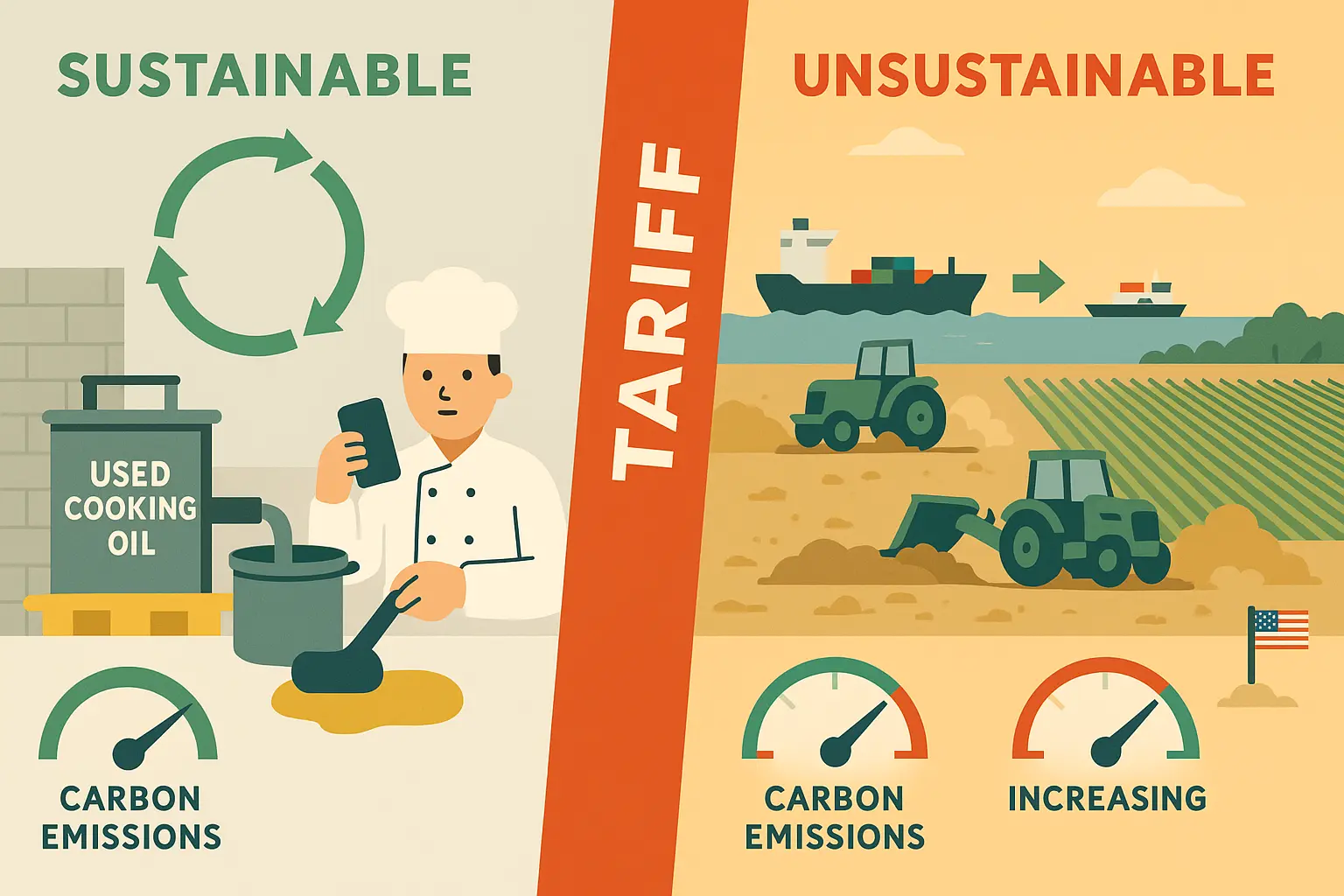Table of Contents
The Trade Policy No One Is Watching
Tariffs are normally framed as economic weapons, but the latest duties on waste derived biofuel feedstocks have quietly become an environmental hazard. Washington’s 125% levy on Chinese used cooking oil (UCO) that took effect in May 2025 has choked the main artery of low carbon feedstock flowing into U.S. refiners, instantly freezing most shipments and diverting volumes toward Europe and Southeast Asia. At the same time, the Environmental Protection Agency is insisting refiners blend a record 5.6 billion gallons of biomass based diesel by 2026, volumes that cannot be met with domestic waste oils alone. The collision of these two policies is already rippling through commodity markets and, more critically, through America’s decarbonization roadmap.
Why UCO Matters for the Planet
Recycled fryer grease is more than kitchen waste; when converted to renewable diesel or sustainable aviation fuel it slashes lifecycle greenhouse gas emissions by up to 74% compared with petroleum diesel. Because the oil already exists, no new land is cleared and no fertilizer is spread, avoiding the “induced land use change” penalty that plagues crop based biofuels. Academic modelling shows biodiesel made from soybean or canola oil carries a significantly heavier emissions burden than fuel made from by product oils like UCO. In other words, each missing gallon of waste based feedstock that tariffs squeeze out of the market is likely to be replaced by a higher carbon alternative, undermining both state Low Carbon Fuel Standards and federal climate goals.
Tariffs in Practice: Supply Shock, Price Shock
The numbers tell the story. U.S. refiners imported roughly 2.8 billion pounds of Chinese UCO in 2024, about half of total imports. With the 125% duty layered on top of existing transport costs, those volumes have collapsed, slashing waste oil liquidity overnight. Traders who once viewed America as the natural sink for Asia’s surplus fryer grease are now rerouting cargoes to Singapore, Rotterdam and Bangkok, while domestic collectors pocket windfall margins. Meanwhile, soy oil futures, long suppressed by competition from cheaper UCO, have surged, signaling that refiners are pivoting to virgin vegetable oils. The immediate winners are Midwestern farmers; the losers are climate constrained policymakers and every fleet operator betting on low carbon diesel economics.
The Environmental Boomerang
Replacing recycled oil with fresh soy or palm oil multiplies emissions, erodes biodiversity and heightens fraud risk. Analysts warn that as UCO prices spike, the incentive to adulterate cargoes with low grade virgin palm oil, and still label them “waste”, rises sharply. At the macro level, shifting demand back to crop oils accelerates land conversion pressures in the Amazon and the U.S. Midwest alike. Every additional million tones of soybean planted to feed biofuel refineries can release more carbon than the diesel it replaces over a 20 year horizon. Paradoxically, a tariff designed to punish foreign suppliers now nudges America toward fuels that score worse on every reputable carbon intensity model. The net effect: higher lifecycle emissions, higher food oil prices, and a squandered opportunity to close the loop on restaurant waste.
A Smarter Path Forward
Trade and climate policy need not be at odds. Congress could carve out tariff exemptions for certified waste oils that pass chain of custody audits, preserving access to low carbon feedstocks while still policing unfair pricing. Harmonizing U.S. definitions with EU voluntary scheme criteria would speed verification and deter fraud. Domestically, scaling municipal collection programs and offering tax credits for commercial kitchens that install secured, leak proof storage tanks can expand home grown supply, easing reliance on imports without reverting to virgin oils. Finally, EPA should adjust Renewable Fuel Standard rules so that feedstock carbon intensity, not origin, drives credit value. Until then, tariffs on fryer grease will keep doing what they do best: raising costs, raising emissions, and undercutting America’s own circular economy ambitions.









